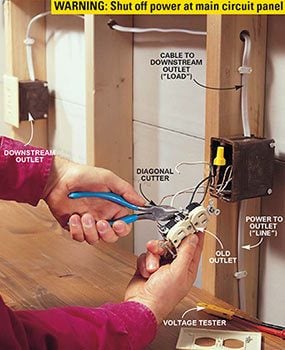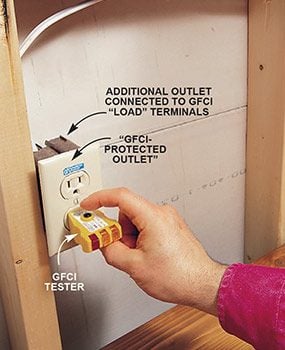Can You Use A Gfci Breaker And Outlet Together
GFCI Plug Receptacle: How to Install GFCI Outlets
GCFI outlets provide cheap insurance against deadly shocks.
![]() Time
Time
A full twenty-four hour period
![]() Complication
Complication
Beginner
![]() Price
Price
Less than $twenty
Introduction
Installing a GFCI outlet doesn't take to be confusing. Follow these steps and photos to install a GFCI without getting line and load connections dislocated.
Tools Required
Materials Required
- Electrical boxes
- Electrical cable
- GFCI outlet
- Wire nuts
- Wire staples
GFCI outlets reduce the danger of mortiferous stupor from faulty plug-in cords and devices. A GFCI (ground fault circuit interrupter) is a special blazon of outlet that detects dangerous footing faults and immediately turns off the power to stop shocks. You lot tin supersede almost whatever electric outlet with a GFCI outlet. Correctly wired GFCIs volition besides protect other outlets on the aforementioned circuit.
While it'due south common to discover GFCI outlets in bathrooms and kitchens, at that place are GFCI outlet requirements. The electrical lawmaking besides requires GFCIs in unfinished basements, garages, most outdoor receptacles and places where construction activeness occurs. Nosotros'll bear witness you how to replace a standard duplex receptacle with a GFCI and wire it to protect other outlets. (For more information nearly wiring outlets, meet Wiring Switches and Outlets).
Project step-by-step (5)
Pace one
Turn Off Ability at the Primary Circuit
- Locate the circuit breaker or fuse that controls the outlet yous plan to supercede and shut off the ability to the circuit.
- Plug a lamp, radio or the GFCI tester into the outlet to test for ability and brand sure it's off.
Step 2
Remove the Old Outlet
- Disconnect the wires by clipping them shut to the outlet.
- Note: Make sure you lot know the deviation between line vs load GFCI, as shown in the photo.

Stride 3
Strip the Wires
- Strip the insulation from the wires to betrayal the amount of wire shown on the stripping approximate located on the back of the GFCI plug receptacle.
- Connect the hot and neutral wires that provide ability to the "line" terminals of the GFCI plug.
- Annotation: The concluding for the neutral wire will be marked "white" or "neutral."

Pace 4
Connect Other Outlets
- Remove the tape roofing the "load" terminals and connect the wires leading to another outlet or outlets to these terminals.
- Note: The white neutral terminal will exist marked.
- Fold the wires back into the box and screw on the GFCI receptacle and encompass plate.

Stride 5
Characterization the Outlets
- Attach the "GFCI-protected outlet" label to downstream outlets.
- Test the downstream outlet by plugging in the GFCI tester and pressing the examination button.
- Note: The lights on the tester should go out.
- Press the reset push on the GFCI to reenergize the outlet.

Check for Required Box Size
When yous pull out the old outlet, count the number of wires in the box. Calculate the minimum box size required for all of the wires plus the GFCI (see "Required Box Size," below). If the existing box is large enough, follow the steps above to replace the outlet with a GFCI. If it'southward too pocket-sized, purchase a larger box earlier proceeding. (For more information on box replacement, see What You Should Practice With Crowded Electrical Boxes).
To figure the minimum box size required past the National Electric Code, add together:
one – for each hot and neutral wire entering the box
1 – for all of the footing wires combined
1 – for all of the cablevision clamps combined (if any)
2 – for each device (switch or outlet—only not light fixtures)
Multiply the total past 2 for 14-approximate wire and two.25 for 12-gauge wire to get the minimum box size required in cubic inches. Plastic boxes have their volume stamped inside. Steel box capacities are listed in the electrical code.
Originally Published: October 09, 2020
Can You Use A Gfci Breaker And Outlet Together,
Source: https://www.familyhandyman.com/project/how-to-install-gfci-outlets/
Posted by: beckdiden1961.blogspot.com


0 Response to "Can You Use A Gfci Breaker And Outlet Together"
Post a Comment